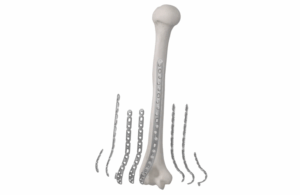The system includes 14 plate families, 2.7 mm and 3.5 mm screw options, and anatomy-specific reduction instruments to address fractures of the distal humerus, proximal ulna, proximal radius, and coronoid process. Each plate features polyaxial locking technology, allowing surgeons to choose between fixed-angle trajectories or screw placement within a 40-degree cone of angulation.
Dr. Gary Updegrove of Penn State Health, who performed the first clinical case using the system, said the design offered strong fixation and ease of use.
“The anatomically contoured plates fit well to the bone and supported fixation with minimal disruption of the triceps,” Updegrove said. “The polyaxial locking holes, combined with calibrated drill guides, helped support precise screw placement and allowed me to achieve strong fixation while easily avoiding intra-articular penetration. As someone who specializes in complex elbow fracture surgery and upper extremity trauma care, I especially appreciated the flexibility of the system — with multiple plate families and screw options available, I could tailor the construct to match the complexity of each fracture pattern in this case. This is exactly the kind of thoughtful design that makes a difference in elbow trauma surgery.”

